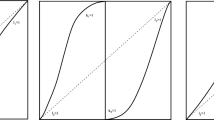Abstract
We consider a generalization of the standard Potts model in which there are q=r+s states with an interaction that distinguishes the two subspecies. We develop a graphical representation (of the FK type) for the system and show that this representation may be incorporated directly into reflection positivity arguments. Using combinations of these techniques, we establish detailed properties of the phase diagram including the existence of sharp triple points. Whenever relevant, the phases are characterized by the percolation properties of the underlying representation.
Similar content being viewed by others
REFERENCES
[AB] M. Aizenman and D. J. Barsky, Sharpness of the phase transition in percolation models, Commun. Math. Phys. 108:489–526 (1987).
[ACCN] M. Aizenman, J. T. Chayes, L. Chayes, and C. M. Newman,Discontinuity of the magnetization in one-dimensional 1/|x-y|2 Ising and Potts models, J. Stat. Phys. 50:1–40 (1988).
[B] M. Biskup, Reflection positivity of the random-cluster measure invalidated for non-integer q, J. Stat. Phys. 92:369–375 (1998).
[BC] C. Borgs and J. Chayes, The covariance matrix of the Potts model: a random cluster analysis, Jour. Stat. Phys. 82:1235–1297 (1996).
[BBCK] M. Biskup, C. Borgs, J. T. Chayes, and R. Kotecký, Gibbs states of graphical representations of the Potts model with external fields, J. Math. Phys. 41:1170–1210 (2000).
[vdBM] J. van den Berg and C. Maes, Disagreement percolation in the study of Markov fields, Ann. Prob. 22:749–763 (1994).
[C] L. Chayes, Discontinuity of the spin-wave stiffness in the two-dimensional XY model, Commun. Math. Phys. 197:623–640 (1998).
[CKS] L. Chayes, R. Kotecký, and S. B. Shlosman, Aggregation and intermediate phases in dilute spin systems, Commun. Math. Phys. 171:203–232 (1995).
[CM] L. Chayes and J. Machta, Graphical representations and cluster algorithms. Part I: Discrete spin systems, Physica A 239:542–601 (1997).
[DS] R. Dobrushin and S. B. Shlosman, Completely analytical interactions: constructive description, J. Stat. Phys. 46:983–1014 (1987).
[ES] R. G. Edwards and A. D. Sokal, Generalization of the Fortuin-Kasteleyn- Swendsen-Wang representation and Monte Carlo algorithm, Phys. Rev. D 38: 2009–2012 (1988).
[vEFS] A. C. D. van Enter, R. Ferná ndez, and A. D. Sokal, Regularity properties and pathologies of position-space renormalization-group transformations: Scope and limitations of Gibbsian theory, J. Stat. Phys. 72:879–1167 (1993).
[FK] C. M. Fortuin and P. W. Kasteleyn, On the random cluster model I. Introduction and relation to other models, Physica 57:536–564 (1972).
[FL] J. Frö hlich and E. H. Lieb, Phase transitions in anisotropic lattice spin systems, Commun. Math. Phys. 60:233–267 (1978).
[Ge] H.-O. Georgii, Gibbs Measures and Phase Transitions, vol. 9, De Gruyter Studies in Mathematics (De Gruyter, Berlin, 1988).
[Gr] G. R. Grimmett, The stochastic random-cluster process and the uniqueness of random-cluster measures, Ann. Prob. 23:1461–1510 (1995).
[KS] R. Kotecký and S. B. Shlosman, First-order transitions in large entropy lattice models, Commun. Math. Phys. 83:493–515 (1982).
[L] T. M. Liggett, Interacting Particle Systems (Springer-Verlag, Heidelberg, New York, 1985).
[LM] J. L. Lebowitz and A. E. Mazel, Improved Peierls argument for high-dimensional Ising models, J. Stat. Phys. 90:1051–1059 (1998).
[LMR] L. Laanait, N. Masaif, and J. Ruiz, Phase coexistence in partially symmetric q-state models, J. Stat. Phys. 72:721–736 (1993).
[MMS] M. V. Menshikov, S. A. Molchanov, and A. F. Sidorenko, Percolation theory and some applications, Series of Probability Theory, Mathematical Physics, Theoretical Cybernetics 24:53–110 (1986).
[MVdV] C. Maes and K. Vande Velde, The fuzzy Potts model, J. Phys. A: Math. Gen. 28:4261–4270 (1995).
[PVdV] C. E. Pfister and K. Vande Velde, Almost sure quasilocality in the random cluster model, J. Stat. Phys. 79:765–774 (1995).
[S] S. B. Shlosman, The method of reflection positivity in the mathematical theory of first-order phase transitions, Russ. Math. Surv. 41(3):83–134 (1986).
[St] V. Strassen, The existence of probability measures with given marginals, Ann. Math. Statist. 36:423–439 (1965).
Author information
Authors and Affiliations
Rights and permissions
About this article
Cite this article
Biskup, M., Chayes, L. & Kotecký, R. Coexistence of Partially Disordered/Ordered Phases in an Extended Potts Model. Journal of Statistical Physics 99, 1169–1206 (2000). https://doi.org/10.1023/A:1018680520737
Issue Date:
DOI: https://doi.org/10.1023/A:1018680520737



